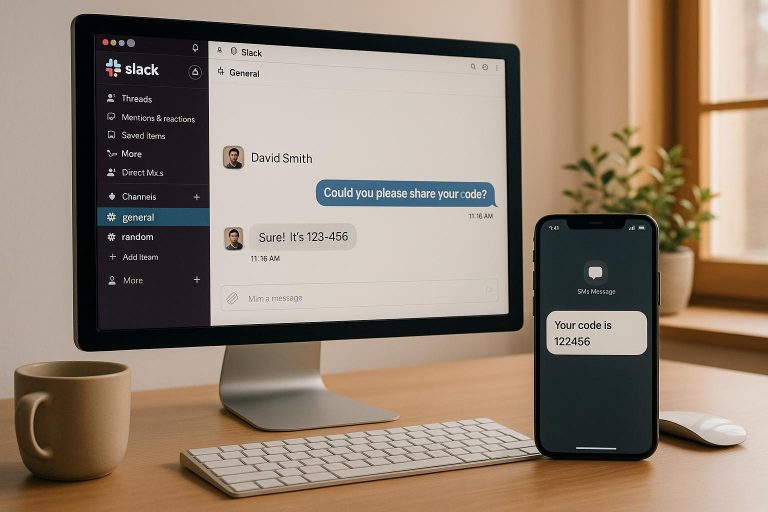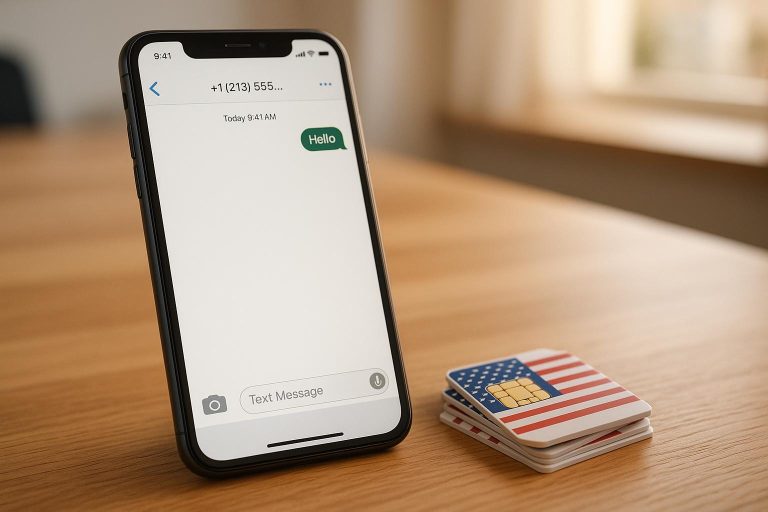2ndLine vs Real Business Numbers: What Startups Need to Know
Choosing the right phone number for your startup is more important than you might think. VoIP services like 2ndLine are cheaper and offer convenience, but they often fail when SMS verification is required. This can block access to essential platforms like Google Workspace, Stripe, or WhatsApp Business, causing delays and disruptions. On the other hand, Real-SIM business numbers – which use physical SIM cards – are reliable and widely accepted for verification across over 1,000 platforms.
Here’s a quick breakdown:
- 2ndLine: Affordable ($9.99/month), easy to set up, great for calls and texts, but often rejected for SMS verification.
- Real-SIM Numbers: Costlier ($50/month), but highly reliable for SMS verification, ensuring access to critical platforms and services.
Quick Comparison
| Feature | 2ndLine (VoIP) | Real-SIM Numbers |
|---|---|---|
| Monthly Cost | $9.99 | $50 |
| SMS Verification Success | Low | 99.9% |
| Platform Compatibility | Limited | Works with 1,000+ |
| Reliability | May fail over time | Consistent |
| Team Integration | Manual sharing required | Automated via APIs |
Bottom Line: If your startup depends on SMS verification, Real-SIM numbers are a safer bet despite the higher cost. For general communication, 2ndLine is a budget-friendly option. Many startups benefit from using both for different purposes.
2ndLine Review: Features and Limitations
2ndLine markets itself as an affordable VoIP solution, offering startups a second phone number for basic business communication needs. While it comes with handy features, its shortcomings become evident when SMS verification is required.
2ndLine Features and Pricing
2ndLine is a mobile app-based service that provides users with a virtual phone number for calls and texts. At $9.99/month, the service includes unlimited calling and texting within the US and Canada, voicemail transcription, and call forwarding. Users can also choose US-based numbers, which helps establish a local presence for businesses.
Additional features like auto-reply and scheduled messaging make it easier to manage customer interactions efficiently.
Benefits for Basic Business Use
For startups focused on routine communication, 2ndLine offers several practical perks. Its quick setup process allows users to get a business number up and running within minutes of downloading the app – perfect for creating a professional image right away.
The cost savings are another major draw. Instead of investing in a separate phone plan, startups can use 2ndLine to add a business line to their existing personal phone plan. This is especially useful for solo entrepreneurs or small teams handling voice calls and basic texting.
The app’s flexibility also stands out. Startups testing different markets can easily switch numbers or add multiple lines as they expand into new regions. Plus, since it’s app-based, team members can access the business line from anywhere with an internet connection. However, while these features are great for everyday use, the service struggles when it comes to SMS verification.
SMS Verification Problems
When it comes to SMS verification, 2ndLine’s VoIP-based nature creates significant challenges. Platforms like WhatsApp Business, Google Workspace, and payment providers such as Stripe often reject 2ndLine numbers during the verification process. This can be a major roadblock for startups that rely on verified communication channels for essential services.
The reason behind these rejections lies in security policies. Many platforms follow guidelines like NIST Special Publication 800-63B, which discourage the use of VoIP numbers for authentication. Unlike traditional phone numbers, VoIP numbers lack a direct physical connection to a device, making them less secure and more prone to issues like SMS delays or failures [1][3].
While 2ndLine works well for day-to-day tasks, its inability to handle stringent verification requirements can disrupt operations. Startups often discover this limitation too late, after committing to the service for critical needs like setting up merchant accounts, advertising, or customer communications [1][2]. The lack of upfront clarity about VoIP restrictions adds to the frustration, leaving users puzzled when verification attempts fail [2].
Real Business Numbers: How Real-SIM Technology Works
Real business numbers mark a departure from traditional VoIP-based systems. Instead of relying on internet protocols, these numbers use physical SIM cards that connect directly to carrier networks – the same networks behind personal cell phones. This approach eliminates many of the verification issues that are common with VoIP numbers.
Real-SIM Numbers Explained
Real-SIM numbers rely on carrier-grade SIM cards that connect directly to cellular networks. This direct connection ensures that SMS verification works seamlessly on platforms like Google, WhatsApp Business, and Stripe. By delivering messages over reliable cellular networks, Real-SIM numbers provide a dependable solution for businesses needing consistent verification.
This technology’s reliability translates into practical benefits, particularly for startups navigating complex operational needs.
Startup-Specific Advantages
Startups benefit greatly from Real-SIM numbers, which are approved by over 1,000 platforms, including essential services like Google Workspace, Stripe, AWS, and WhatsApp Business. With a 99.9% SMS delivery rate, businesses can avoid delays during critical tasks, such as setting up merchant accounts or verifying banking details.
Real-SIM solutions also improve team workflows. Tools like JoltSMS integrate directly with platforms like Slack and Discord via webhooks, allowing entire teams to receive verification codes in real time. For businesses handling bulk or multi-account setups, REST API integration simplifies and automates the process.
Another key advantage is long-term reliability. Unlike VoIP numbers, which can become unreliable or flagged over time, Real-SIM numbers maintain consistent performance. This reduces the risk of losing access to vital accounts, offering businesses peace of mind.
Cost and Service Terms
Real-SIM business numbers are typically offered through a monthly subscription model. For instance, JoltSMS provides dedicated US numbers for $50 per month, including unlimited inbound SMS, with a minimum 30-day commitment.
Many providers offer flexible options like auto-renewals and easy cancellations to ensure numbers remain active and adaptable to changing needs. Additional perks, such as 24/7 support and money-back guarantees, further highlight the dependability of Real-SIM solutions compared to consumer-focused VoIP alternatives.
2ndLine vs Real Business Numbers: Direct Comparison
Let’s break down the differences between 2ndLine and real-SIM business numbers to see how they stack up.
Feature Comparison Chart
| Feature | 2ndLine (VoIP) | Real-SIM Business Numbers (JoltSMS) |
|---|---|---|
| SMS Verification Success Rate | Often disrupted by platform restrictions | 99.9% success on over 1,000 platforms |
| Monthly Cost | Generally cheaper (varies by provider) | $50/month |
| Platform Compatibility | May face blocks on key platforms | Works seamlessly with Google, Stripe, AWS, banking, and more |
| Team Integration | Limited to basic calling and manual code sharing | Automated delivery via Slack/Discord webhooks & REST API |
| Number Longevity | Virtual numbers may get reassigned | Dedicated, private numbers for the rental period |
| Re-verification Reliability | Prone to failures over time | Consistently reliable with a money-back guarantee |
| Support Level | Standard customer support | 24/7 dedicated business support |
| Minimum Commitment | Month-to-month plans available | 30-day minimum rental |
Real-SIM numbers stand out for their enterprise-grade reliability, which is especially important when SMS verification is a key part of your operations. The chart makes it clear: real-SIM outshines VoIP in several critical areas. But let’s dive deeper into why this is the case.
Why Real-SIM Beats VoIP for Verification
The main issue with VoIP is its reliance on internet protocols, which makes it vulnerable to platform blocks. Many companies, as a safeguard against fraud, restrict VoIP numbers from being used for verification. Real-SIM, on the other hand, operates through a direct cellular connection, bypassing these restrictions and ensuring verification codes are delivered without triggering security filters.
While VoIP numbers might work initially, they often fail when platforms require re-verification. Real-SIM numbers don’t have this problem – they consistently pass even the toughest verification checks. On top of that, real-SIM automates the process by delivering codes directly to Slack or Discord, saving time and eliminating the need for manual sharing. For larger-scale operations, REST API integration makes bulk verification seamless and efficient.
For startups and businesses that rely heavily on reliable SMS verification, real-SIM offers a practical solution that addresses the limitations of VoIP services. It’s a clear choice for those who need dependable, scalable, and secure verification options.
sbb-itb-070b8f8
When Startups Need Real Business Numbers
Setting up your startup for success means investing in the right tools, and one of those tools is real business numbers. While VoIP services are great for many tasks, there are certain situations where only real-SIM technology can deliver the reliability you need. Skipping this step can lead to costly delays and frustrating verification failures.
Scenarios Where Real Numbers Are Non-Negotiable
Real numbers become critical when SMS verification challenges arise. Let’s break down the key scenarios where they’re absolutely essential:
1. Platform Onboarding That Rejects VoIP Numbers
Some platforms simply won’t accept VoIP numbers for account verification. If your business relies on services like Google Workspace, AWS, Stripe, banking apps, or cryptocurrency exchanges, you’ll need a real number to get started. Without one, you might find yourself blocked from accessing these essential tools.
2. Verifying Accounts Across Multiple Platforms
Startups often juggle accounts on dozens of platforms – payment processors, cloud services, marketing tools, and more. Real-SIM numbers streamline this process by working seamlessly across over 1,000 platforms, reducing the risk of verification hiccups and saving valuable time.
3. Managing Team-Based Operations
When multiple team members need access to verification codes, sharing them manually can quickly become a logistical nightmare. Services like JoltSMS solve this problem by delivering codes directly to shared Slack or Discord channels. This ensures instant access for your team while maintaining security.
4. Ensuring Long-Term Business Continuity
VoIP numbers can be reassigned or blocked over time, which means you might have to update your phone number across all your accounts – a tedious and risky process. Some platforms make it nearly impossible to change verification numbers, leaving you locked out of critical accounts. Real-SIM numbers, on the other hand, stay dedicated to your business for the entire rental period, eliminating this headache.
5. Handling High-Stakes Verification Scenarios
Certain situations – like launching a sensitive campaign, processing time-critical payments, or accessing accounts during a crisis – demand absolute reliability. In these moments, you can’t afford for verification codes to fail. Real-SIM technology ensures dependable delivery, even in high-pressure situations.
Combining VoIP and Real Numbers for Maximum Efficiency
For startups looking to balance cost and reliability, the smartest approach is to use VoIP for calls and real numbers for SMS verification. Each serves a distinct purpose, and together, they create a seamless communication system.
- Use VoIP for everyday communication. Services like 2ndLine are perfect for handling customer calls, internal team discussions, and general business needs. They’re affordable and come with helpful features like call forwarding, voicemail, and multi-line extensions.
- Rely on real-SIM numbers for SMS verification. Platforms like JoltSMS focus exclusively on verification, ensuring your codes are delivered reliably. While the $50/month cost may seem steep at first, it’s a small price to pay when you consider the time and security it saves.
- Integrate both into your workflows. For example, your customer service team can stick with VoIP for calls, while your tech team uses real-SIM numbers for platform access and API integrations. With REST API support, you can even automate verification processes for added efficiency.
- Plan for growth. As your business expands, you may need multiple real-SIM numbers for different purposes – one for financial tools, another for marketing platforms, and a third for development services. Meanwhile, VoIP can handle the increasing volume of customer communications.
Making the Right Choice for Your Startup
When deciding between VoIP services like 2ndLine and real-SIM business numbers, it’s not just about the price tag – it’s about reliability, platform acceptance, and ensuring your business runs smoothly. A wrong decision can lead to verification failures and locked accounts, which could disrupt your operations.
Key Factors to Consider
Platform Compatibility is a standout advantage of real-SIM numbers. Unlike VoIP numbers, which are often rejected, real-SIM numbers work seamlessly with over 1,000 major platforms, including Google Workspace, AWS, Stripe, banking apps, and cryptocurrency exchanges. This compatibility ensures you can set up and maintain access to the tools your business depends on.
Team Collaboration becomes increasingly important as your startup scales. Real-SIM services simplify this by automatically delivering verification codes to shared channels via webhooks. This means no delays or bottlenecks – your team can access critical platforms without hassle.
Long-term Stability is another critical consideration. VoIP numbers can be reassigned or blocked over time, potentially locking you out of accounts where phone number changes are complicated or even impossible. Real-SIM numbers, on the other hand, remain dedicated to your business for the entire rental period, providing peace of mind.
Cost Structure is where startups often hesitate. While services like 2ndLine appear cheaper upfront, the hidden costs of verification failures, troubleshooting, and account lockouts can quickly outweigh the savings. At $50 per month, a service like JoltSMS may seem like a higher investment, but it guarantees SMS verification success and even offers a money-back refund if the number fails.
Steps to Take for Your Startup
Start by evaluating your SMS verification needs. Make a list of all the platforms your business currently uses or plans to use – such as payment processors, cloud services, banking apps, and marketing tools. If you’ve experienced verification failures or platform rejections with your current VoIP number, it’s time to explore a real-SIM solution.
Next, test your current setup. Try verifying accounts on key platforms and note any errors like “This number cannot be used for verification.” Many startups only realize their VoIP number is problematic when they encounter these issues during critical moments.
Assess the hidden costs of verification failures. Think about the time spent troubleshooting, delays in accessing platforms, and potential revenue lost. For most startups, the monthly cost of a reliable real-SIM number is a small price to pay compared to these disruptions.
Consider a hybrid approach for flexibility. Use your VoIP service for everyday calls and customer communication, while reserving a real-SIM number specifically for SMS verification. This way, you balance affordability with reliability.
Finally, plan for scalability. Choose a service that grows with your business, offering features like REST API integration, webhook support, and team collaboration tools. These capabilities will save you from the hassle of switching providers as your needs evolve.
When it comes to SMS verification, reliability should always take priority over cost. The platforms requiring verification – like payment processors, cloud services, and banking apps – are vital to your operations. A small upfront investment now can prevent costly disruptions later, setting your startup on a path for smooth growth.
FAQs
Why are VoIP numbers often rejected for SMS verification by platforms like Google Workspace and Stripe?
Platforms such as Google Workspace and Stripe often decline VoIP numbers for SMS verification. The main reason? VoIP numbers can’t reliably confirm ownership of a physical device, a key security safeguard. Additionally, these numbers are more susceptible to fraud since they can be easily spoofed or tampered with, making them less trustworthy for verification.
To enhance security and minimize misuse, many platforms insist on using real mobile numbers. These are linked to physical SIM cards, offering a stronger and more dependable form of authentication.
What’s the best way for startups to balance affordability and reliability between 2ndLine and real SIM-based numbers?
Startups can manage their communication needs effectively by combining 2ndLine virtual numbers and real SIM-based numbers. Virtual numbers are a budget-friendly option, typically costing between $10 and $50 per month, making them ideal for everyday communication. However, they often struggle with platform acceptance when it comes to tasks like SMS verification.
On the other hand, real SIM-based numbers, though slightly more expensive, are far more dependable and widely accepted by platforms such as WhatsApp, Google, and Stripe. By using virtual numbers for routine interactions and reserving real SIM-based numbers for verification-heavy tasks, startups can strike the perfect balance between affordability, dependability, and security.
What risks do startups face when using only VoIP numbers for SMS verification?
Using VoIP numbers for SMS verification might seem convenient at first, but it often comes with a host of challenges. Many platforms actively block VoIP numbers for verification purposes, which can disrupt essential operations and lock you out of critical services like WhatsApp or Google Workspace. This can cause unnecessary delays and headaches for your team.
On top of that, VoIP numbers are more prone to security threats such as SIM swapping, spoofing, and phishing attacks. These vulnerabilities can put your sensitive business accounts at risk, potentially leading to fraud, data breaches, and a loss of trust. For startups, relying on real SIM-based numbers is a smarter choice, offering better reliability, stronger security, and seamless compatibility with key platforms.







